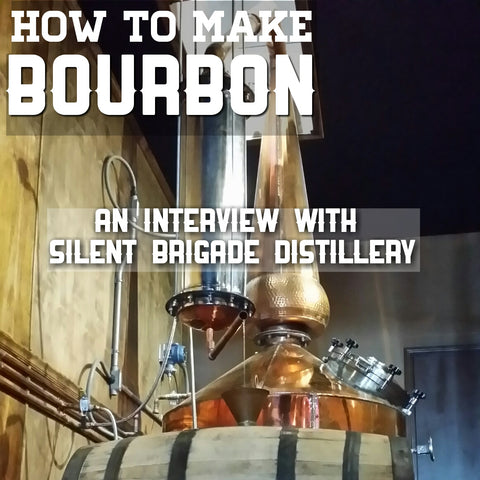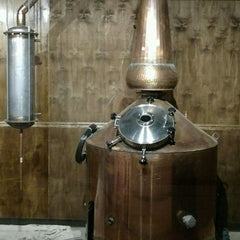This blog provides information for educational purposes only. Read our complete summary for more info.
How to Make Bourbon with Silent Brigade Distillery

We are so excited to share our most recent chat with you. This time, we got to talk with John Brown of Silent Brigade Distillery, a relative newcomer to the distilling game. However, they've already got people talking about their Bourbon, distilled in a hand built, copper pot still.
How to Make Bourbon Step by Step
This is an interview with the founders of Silent Brigade. They make top shelf Bourbon and have a lot to say about how it's best done. If that's what you're looking for, read on. Though, here's the article you should read if you'd like to know how to make Bourbon with step by step descriptions of each part of the process.
The origin of Silent Brigade
Silent Brigade opened in the spring of 2014 in Paducah, Kentucky, a city with a rich history in distilling -- at one point, the city was home to 14 different distilleries. But the barrels were dry for decades, until Silent Brigade came around earlier this year. John Brown and his team are the first to open a distillery in Paducah since Prohibition. And already, they are making a big splash. They have set themselves apart from other Kentucky distilleries by making a wheated bourbon (read more about it in our interview with them below!)They hope to become part of Kentucky’s famed Bourbon Trail next year, joining longstanding bourbon-makers such as Bulleit, Jim Beam and Woodford Reserve.
Crafted, Engineered and Bottled by Hand
The guys at Silent Brigade came to distilling from engineering and welding, backgrounds that lent themselves perfectly to designing stills. It started as a hobby for them: They’d work out the copper, play with the design and come up with stills they’d sell to other people. John Brown had been making his own wine for a bit, and made the natural progression to attempting his own spirits. He even helped develop liquor recipes for some of the folks who bought their stills. Eventually, they decided to make the leap to opening their own distillery. It wasn’t an easy process: regulations in Kentucky are strict, and federal permits take time before they get approved. A new Kentucky law, though, could be a game-changer for distilleries like Silent Brigade. The law allows Silent Brigade and other distilleries to sell liquor that can be consumed on-site, giving distilleries the chance to offer more than just tasting rooms to spirit enthusiasts.
John Brown’s tips and insights made us want to take a road trip to Paducah. We hope you enjoy reading it as much as we enjoyed talking with him.
Before we get started, a reminder: Distilling alcohol is illegal without a federal fuel alcohol or distilled spirit plant permit as well as relevant state permits. Our distillation equipment is designed for legal uses only and the information in this article is for educational purposes only. Please read our complete legal summary for more information on the legalities of distillation.
Copper Still Design

Clawhammer Supply: As a company that sells copper moonshine still kits, we are super interested in the fact that you built your own stills. Can you tell us a bit about that? What were you looking for in the design that did not exist elsewhere? How did you settle on a design? How do you think the design affects the taste of your bourbon and moonshines?
Silent Brigade: We have used plate columns from time to time and realized we were getting the most flavor from a pot still. I have always love the Irish pot stills like you see at all the old distilleries in Ireland and Scotland so we decided to create our garage version of that and couldn’t be more satisfied. If you are looking to make a great-tasting spirit, whether it be a bourbon, moonshine or anything else, a pot still is the way to go. Why strip out the flavor?
Clawhammer Supply: We completely agree with that! We designed our still with that same principle in mind. You two have a seemingly perfect background for creating your own stills -- one of you is a welder and the other an engineer. How did you get interested in building stills?
Silent Brigade: We started building our own then built one to sell on eBay. It was only posted for two days before it sold, so we started building a few for start-up distilleries.
Clawhammer Supply: That is funny- that is how Clawhammer Supply started. Kyle built a still for himself and made an extra still with left over copper and sold it. He soon realized that there were a lot of people looking for a high quality copper stills. What lessons have you learned over time about designing and building your own stills?
Silent Brigade: One thing in particular is safety. It is very important to build a still that will always have an open vapor flow without any possible obstructions.
Clawhammer Supply: This is a very good point and something that every still manufacturer should follow. We decided to take it a step further and install a pressure relief valve standard on our stainless steel stills. Even though our stills have an open vapor flow design we added it in case of some freak occurrence where the column were to get blocked.
The Bourbon Mash Process
Clawhammer Supply: What size mash tuns do you use?
Silent Brigade: We use 500 gallon mash tuns. They work very well for our process.
Clawhammer Supply: What materials are your mash tuns made from?
Silent Brigade: The mash tuns we use for the moonshine are made of a food grade plastic.
Clawhammer Supply: What is your process for mashing? Do you try and hit a specific mash temperature -- if so, do you have temperature control in place for this?
Silent Brigade: Mashing in our Bourbon, we heat up to 180-200F for around two hours, then cool down to the 150’s and add the enzyme to break down the starches to fermentable sugars
Clawhammer Supply: There are a lot of folks who are interested in finding a good bourbon recipe. We know that The Federal Standards of Identity for Distilled Spirits (27 C.F.R. 5) state that bourbon made for U.S. consumption must meet a number of parameters, including being made from a grain mixture that is at least 51 percent corn, distilled to no more than 160 proof and aged in new, charred oak barrels. (For more info, check out this link.) Can you give us any hints on the grain bill for your bourbon? We obviously know you have at least 51% corn, but can you give us any insight to the rest of the grain bill? (We obviously don’t want any distillery secrets, but can you give us a good starting place to make a good bourbon?)
Silent Brigade: We were making a Bourbon with the flavor characteristics that we chose from 3 different mash bills that we were experimenting with. We liked the Wheated Bourbons the most and were not a huge fan of the heavy rye mash bills, so we were looking to make a Wheated Bourbon. Through trial and error, we started using a little more barley than wheat, and were the most impressed by the barley’s flavor, which carried a heavy nutty/chocolate flavor through to the distillate. Our mash bill is 70 percent corn, 20 percent barley, 10 percent wheat and no rye.
Bourbon Fermentation and Yeast
Clawhammer Supply: Do you ferment in open or closed fermenters? Why did you make that choice?
Silent Brigade: We use open fermenters, no particular reason. One day, we will be switching over to large stainless, but right now, we are trying to keep our small budget balanced. Most of the larger distilleries all had open fermenters until 9/11 happened, and they closed them up.
Clawhammer Supply: What size fermenters do you use?
Silent Brigade: 500 gallon
Clawhammer Supply: Do you ferment on the grains?
Silent Brigade: Yes for now we do, but we have been wanting to try pumping the beer from the grain to finish the ferment in a different tank one day soon.
Clawhammer Supply: How do you guys handle temperature control and how have you handled any issues with temperature during fermentations? What temperature do you ferment at?
Silent Brigade: We are lucky enough to have climate control in our mash room which is all new for us but we are really digging it. Our cold ferment tuns stay around 68-73F degrees.
Bourbon Distillation Process
Clawhammer Supply: How many stills do you have? If more than one do you use one for stripping runs and one for spirit runs?
Silent Brigade: We have 3 stills now but we do not do a stripping run currently.
Clawhammer Supply: What size are your stills? Why did you choose to build them that size?
Silent Brigade: We have a 300 gallon,33 gallon,and 50 gallon, soon we will be building a 500 gallon to double our capacity.
Clawhammer Supply: Do you distill on the grains?
Silent Brigade: no
Clawhammer Supply: Tell us more about your distilling process -- do you do just one run or do you do multiple runs?
Silent Brigade: We just run one pass thru our still and filter for final product.
Clawhammer Supply: What do you do with the heads and tails? Do you save them to re-distill? Why or why not?
Silent Brigade: We re-run our tails with our next run, we throw away the fore shots and use part of the heads to cut in with the distillate to add some of the sweet to the flavor.
Clawhammer Supply: What yeast are you using and how did you come to choose that yeast?
Silent Brigade: We use a variety of dry yeast, one is a yeast strain from Sweden along with a champagne yeast we get here from the states.
Bourbon Aging Process
Clawhammer Supply: We know the distillery is young, having only started this year, but we are interested in hearing more about your aging process. How much of your product is going into barrels for aging?
Silent Brigade: We are just on the verge of steady filling Bourbon barrels. Right now, we just have a few filled, along with a Brandy aging.
Clawhammer Supply: What size barrels are you using to age, and what materials are they made from? Are you using different barrels for different products? We know that bourbon has to be aged in new oak barrels but are you using your oak barrels after the bourbon is finished on other spirits?
Silent Brigade: We plan to use 15 gallon barrels for our first release of bourbon but we will be also filling brand new white oak 53 gallon barrels for a 2- and 4-year bourbon as well.
Distilled Spirits Ingredients
Clawhammer Supply: We heard you guys are using heirloom dent corn from Suwanee, Kentucky, for your moonshine. Why did you choose an heirloom variety? What does that add to your moonshine?
Silent Brigade: We started out using the heirloom corn and it has an interesting flavor for the moonshine, but to get the yield we are wanting for the bourbon, we have switched to #1 yellow dent food grade corn. It seems to have more yield due to the larger amount of starch in the corn.
Clawhammer Supply: We also hear that your cider comes from apples and peaches grown not far away, in southern Illinois. Why did you choose those ingredients?
Silent Brigade: We were trying to stay away from synthetic flavors we wanted to have a product made from all natural sources. The taste is so much better.
Bourbon Distillery Details
Clawhammer Supply: We love the history and story behind the distillery’s name, and that it came from a secret “hot-headed,” as you say, sect that was fighting for tobacco farmers’ rights in the early 1900s. Why were you drawn to that name, and what did you hope it would come to mean for the distillery?
Silent Brigade: We wanted the name of our distillery to be tied in with some local history and came across this story of rebellion from the farmers against a monopoly in the trade business and it reminded us of our own selves.
Clawhammer Supply: You guys are producing the first bourbon made in Paducah since Prohibition, but Paducah and Kentucky have a long history of bourbon and whiskey-making. How do you distinguish yourself from the rest of the distilleries out there?
Silent Brigade: We know that we are just the little guys and before the prohibition there were many more little distilleries everywhere in Kentucky and that is making a comeback. We know that there is enough room for us and just having a whiskey that tastes a little different is very good for the consumer. We feel if we try to make a great product, we will build a consumer base that will return to buy our product for sure.
Clawhammer Supply: Kentucky’s state legislature recently passed a law allowing distilleries to sell drinks by the glass. How has that influenced your business plan?
Silent Brigade: We knew about the bill going through so that was actually part of our business plan from the beginning. We hoped it would also supply enough income to steady buy barrels for all of our aged spirits. It is a great thing.
Clawhammer Supply: You guys have recently partnered with Jay Rogers of Silver Trail distillery. (For our readers: Silver Trail was destroyed in an explosion in 2015. It was a horrific event that left one person dead.) Why did you decide to partner with Jay?
Silent Brigade: We have always respected Jay and when the opportunity arose to do some business, it wasn’t a hard choice. Jay is a very honest man and you can tell that from the first time you meet him.
Clawhammer Supply: The explosion really brought attention to the risks of distilling, and we know Jay sometimes gives safety talks for visitors at Silent Brigade. What safety lessons do you think distillers need, and what would you say about safety to home distillers?
Silent Brigade: Not just anyone needs to take on this hobby -- there are many different dangers in distilling. Common sense is a must. There are some folks that do not need to be cooking frozen pizza, let alone flammable dangerous distillates. Paying attention to your surroundings, and knowing your dangers ahead of time. Research, research and research some more. No more people than needed to make the run. Always know where everyone is and what they are doing.
Clawhammer Supply: We hear from a lot of the distilleries we talk to that starting a distillery and getting it off the ground and running is a lot trickier than they originally thought. What surprised you about the process?
Silent Brigade: Making the spirits is easy, getting the distributors is the hardest part.
Clawhammer Supply: What advice would you offer folks who want to start their own distillery?
Silent Brigade: Start as small as you can, it will cost a lot more than you think by the time it hits the shelves. Expect the process from start to end 1 ½ -2 years. Try to create something different to your area. You can throw a rock up in the air in Kentucky and hit someone that can make moonshine.
If you're interested in learning more about Silent Brigade Distillery you can do so right here.




Great article..
I love your site all the way around.
Keep you the great work!!
hi can I use oak chips for my bourbon
Great article! I have a question about grains and sugars. When selecting corn and rye, which produces best alcohol levels: flaked, ground or crushed? Also, an debating on whether to use all sugar or blend of sugar and molasses. Any recommendations on blending percentage? I’m using a 10 gallon copper pot still with copper thumper. Worm is about 20 feet of coiled copper.
Your interview was great, and it helped me out alot thanks for the info.now give me a deal on a 8 gallon still…..
Lol